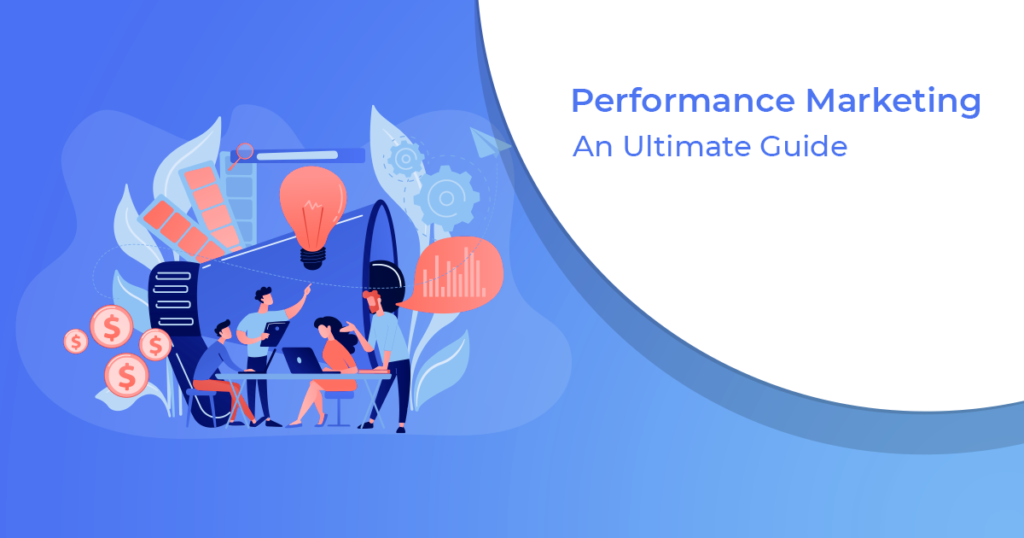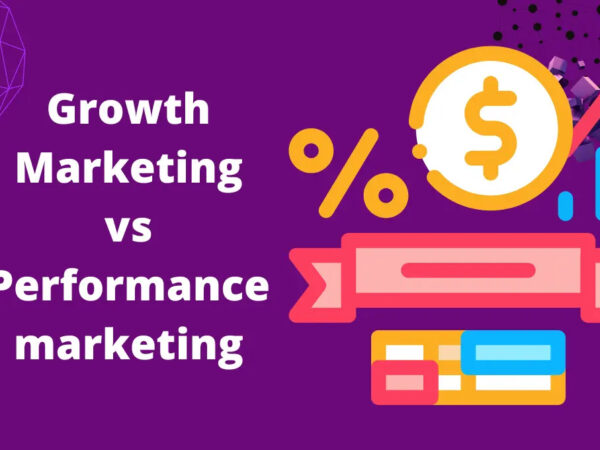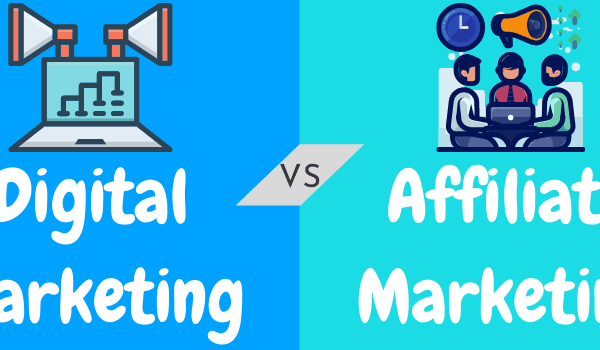
- Introduction
- What is Performance Marketing?
- How is it different?
- Why is Performance Marketing Important for Businesses?
- What are Some Performance Marketing Strategies and Channels?
- Some Key Strategies to Boost Your Performance Game
- 1. Search engine marketing (SEM)
- 2. Search engine optimization (SEO)
- 3. Pay-per-click advertising (PPC)
- 4. Display advertising
- 5. Affiliate marketing
- 6. Social media marketing
- 7. Email marketing
- 8. Content marketing
- How to Create a Powerful Performance Marketing Plan?
- Step I: Conducting market research
- Step II: Setting goals and KPIs
- Step III: Identifying target audience and buyer personas
- Step IV: Crafting a messaging and positioning strategy
- Step V: Selecting the right performance marketing channels
- Step VI: Creating a budget and timeline
- Rev Up Your ROI: Creative Ways to Optimize Performance Marketing
- 1. A/B testing and experimentation
- 2.Tracking and analyzing data
- 3. Measuring ROI and attribution
- 4. Optimizing landing pages and conversion rates
- 5. Best practices for optimizing performance marketing campaigns
- The Thrills and Spills of Measuring Success
- Outpacing the Pack: Why Performance Marketing is the New Marketing Standard
- The Performance Marketing Maze: Overcoming Common Obstacles
- Common challenges:
- Strategies to Buckle Up and Brace for Impact
- How to Pick the Right Partner for Your Performance Marketing Needs?
- Factors to Consider When Selecting a Performance Marketing Agency that Delivers
- Hiring an Agency? Don’t Forget to Ask These Quirky Questions
- Case Studies: Successful Performance Marketing Campaigns
- Airbnb
- Uber
- Spotify
- Amazon
- Some Discoveries from Real-World Marketing Examples
- Exploring the Future of Performance Marketing
- Ready to Boost Your Marketing Results?
- Related Articles
The Ultimate Guide to Performance Marketing: Your Ready Reckoner to Success
Introduction
Welcome to the world of performance marketing Did you know that businesses that use performance marketing strategies are able to increase their revenue by up to 24%? And that’s not all, a whopping 83% of marketers agree that performance marketing is the most effective way to achieve their goals.
If you’re new to the concept of performance marketing, don’t worry, we’ve got you covered. In this ultimate guide, we’ll take you through everything you need to know to get started with performance marketing and how it can help you achieve success. So buckle up and get ready to take your marketing game to the next level!
With that said, let’s have a look at the definition.
What is Performance Marketing?
Performance marketing refers to a digital marketing strategy that focuses on driving measurable actions or conversions, such as clicks, leads, or sales. This type of marketing approach uses data analytics to track and measure the success of campaigns in real-time, allowing marketers to make data-driven decisions and optimize their efforts for maximum results.
How is it different?
Performance marketing is highly targeted and personalized, aiming to deliver the right message to the right audience at the right time.
It encompasses various tactics, including search engine optimization, paid search, affiliate marketing, email marketing, and social media advertising, among others. We’ll discuss in more detail in the upcoming part.
What can it achieve?
The ultimate goal of performance marketing is to achieve a positive return on investment (ROI) and drive revenue growth.
By focusing on measurable outcomes and optimizing campaigns accordingly, performance marketing can help businesses of all sizes to achieve their marketing goals and drive success.
Why is Performance Marketing Important for Businesses?
Performance marketing has become an essential element for businesses that are looking to grow and expand their reach. As we mentioned earlier, this type of marketing is focused on measurable results, and it allows businesses to track the effectiveness of their campaigns in real-time.
The importance of performance marketing lies in its ability to provide businesses with valuable insights into their customers’ behavior and preferences. With this information, businesses can optimize their marketing strategies to reach their target audience more effectively. Here are some more reasons why performance marketing is important:
- Helps increase sales and revenue
- Targets specific audiences
- Enables efficient budget allocation
- Offers flexibility and scalability
- Enhances brand awareness
- Generates high ROI
- Enables data-driven decision making
- Facilitates testing and optimization
- Helps businesses stay competitive in the market.
What are Some Performance Marketing Strategies and Channels?
Performance marketing encompasses a range of strategies and channels that are designed to drive measurable results. Some of the most common performance marketing channels include search engine marketing, affiliate marketing, social media advertising, and email marketing.
These channels allow businesses to reach their target audience across multiple touchpoints and track their interactions with their brand.
One of the key strategies in performance marketing is to focus on targeting specific customer segments.
Another critical aspect of performance marketing is testing and optimization.
By continually testing different strategies and channels, businesses can refine their approach and improve their results over time.
This includes testing different ad creatives, landing pages, and messaging to identify the most effective combinations for driving conversions and revenue.
Ultimately, the key to success in performance marketing is to remain data-driven and focused on achieving measurable results.
Some Key Strategies to Boost Your Performance Game
We see that performance marketing is a results-driven approach to marketing that focuses on generating measurable outcomes.
To succeed in performance marketing, businesses must adopt key strategies that can help them achieve their desired goals.
These strategies include setting clear objectives, identifying and targeting the right audience, leveraging data analytics to optimize campaigns, creating compelling content, and continuously testing and refining campaigns to improve performance.
Apart from these, there are some more effective ways that marketers should choose.
They are:
1. Search engine marketing (SEM)
Search engine marketing (SEM) is one of the key performance marketing strategies that businesses use to increase their online visibility and reach their target audience.
SEM involves the use of paid search advertising, also known as pay-per-click (PPC), where businesses bid on relevant keywords and phrases to display their ads on search engine result pages (SERPs). Here are some benefits of using SEM:
- SEM (Search Engine Marketing) allows targeting specific keywords to drive website traffic.
- It offers immediate visibility and quick results compared to SEO (Search Engine Optimization).
- SEM offers measurable results and insights for optimization.
- It enables businesses to reach the right audience at the right time with targeted ads.
- It helps increase brand awareness and online presence.
- SEM allows businesses to set their own budget and control ad spend.
- It facilitates retargeting and remarketing to reach potential customers who have shown interest before.
- It offers a competitive edge by targeting competitor keywords.
- SEM can be optimized for local and mobile searches.
2. Search engine optimization (SEO)
Search engine optimization (SEO) is one of the most important performance marketing strategies that can help businesses drive targeted traffic to their websites. SEO is the process of optimizing a website or online content to improve its visibility and ranking in search engine results pages (SERPs).
With effective SEO techniques, businesses can increase their website’s organic traffic and reach more potential customers. This can be achieved by optimizing website content, keywords, meta descriptions, and tags, as well as building high-quality backlinks from other reputable websites. Here’s what all SEO can do:
- SEO can improve website traffic and visibility.
- It helps to target relevant keywords and drive qualified leads.
- SEO can increase brand credibility and authority.
- It can enhance user experience and engagement.
- SEO can lead to higher conversion rates and revenue.
Overall, SEO is a critical aspect of any successful performance marketing strategy and should not be overlooked.
3. Pay-per-click advertising (PPC)
Pay-per-click advertising (PPC) is a popular performance marketing strategy that allows businesses to promote their products or services on search engines, social media platforms, and other websites.
With PPC, advertisers only pay when a user clicks on their ad, making it a cost-effective way to drive traffic and generate leads. PPC also provides businesses with the ability to target specific audiences based on demographics, interests, and online behaviors, allowing them to reach the right people at the right time.
Here’s what all PPC can do:
- Targets specific audience
- Provides measurable results
- Offers control over budget
- Helps to achieve quick results
- Enables easy A/B testing
- Provides valuable insights for other marketing channels
- Maximizes ROI by optimizing campaigns
- Allows targeting of keywords with commercial intent
- Provides a competitive edge in the market
- Helps in brand awareness and recognition.
Overall, PPC is a valuable tool for businesses looking to drive measurable results and increase brand visibility online.
4. Display advertising
Display advertising is a critical component of performance marketing strategies. Display ads are typically image-based ads that appear on websites, social media platforms, and mobile apps.
The main goal of display advertising is to attract the attention of potential customers and drive them to take action, such as clicking on the ad, visiting the advertiser’s website, or making a purchase.
Display ads are highly targeted, and they allow advertisers to reach specific audiences based on factors such as location, interests, and demographics. Here are some benefits of display advertising:
- Increases brand visibility
- Targets specific audience demographics
- Drives traffic to a website
- Generates leads
- Improves conversion rates
- Provides measurable results
- Enhances customer engagement
- Increases sales revenue
- Builds brand reputation
- Improves return on investment (ROI)
5. Affiliate marketing
Affiliate marketing is a crucial aspect of performance marketing strategies. It involves a partnership between a brand and an affiliate marketer who promotes the brand’s products or services. The affiliate earns a commission for each sale or lead generated through their unique affiliate link.
This strategy is particularly effective because it allows brands to expand their reach and tap into the affiliate’s audience, while the affiliate benefits from a passive income stream. Here are some common benefits of affiliate marketing:
- Generates incremental revenue
- Drives traffic and engagement
- Targets specific audiences
- Cost-effective
- Builds brand awareness
- Provides measurable results
- Enhances SEO
- Low-risk for advertisers
- High-reward for affiliates
- Enables partnerships and collaborations
With the right affiliate partnerships and a solid tracking and reporting system in place, affiliate marketing can be a powerful tool for driving conversions and increasing revenue.
6. Social media marketing
Social media marketing has become one of the key performance marketing strategies for businesses of all sizes. With over 4.48 billion people using social media worldwide, platforms such as Facebook, Instagram, Twitter, and LinkedIn have become powerful tools for reaching target audiences and driving conversions.
Social media marketing allows businesses to build brand awareness, engage with their customers, and drive website traffic through targeted ads, influencer partnerships, and organic content.
By measuring engagement, click-through rates, and conversions, businesses can track the success of their social media marketing efforts and adjust their strategies accordingly. Let’s look some common benefits:
- Provides a targeted audience reach.
- Builds brand awareness and visibility.
- Drives website traffic and lead generation.
- Enables customer engagement and relationship building.
- Offers data analytics and measurement tools.
- Supports personalized content and messaging.
- Facilitates influencer and user-generated content.
- Allows for cost-effective and efficient ad campaigns.
- Integrates with other digital marketing channels.
- Continuously evolves with new features and trends.
As social media platforms continue to evolve, it is important for businesses to stay up-to-date with the latest trends and best practices to ensure they are effectively leveraging this powerful marketing channel.
7. Email marketing
Email marketing is a crucial component of a successful performance marketing strategy. It involves sending targeted messages to a list of subscribers who have willingly provided their email addresses.
Email marketing is an effective way to promote products or services, build brand awareness, and generate leads. The success of email marketing campaigns can be measured by key performance indicators such as open rates, click-through rates, conversion rates, and revenue generated.
Here are some benefits of email marketing:
- Helps reach a large audience
- Builds brand awareness
- Personalization options increase engagement
- Provides measurable results
- Cost-effective compared to traditional marketing
- Allows for targeted messaging
- Supports lead generation
- Increases customer loyalty
- Provides opportunity for segmentation and testing
- Enables automation for efficiency.
A well-executed email marketing campaign can yield significant returns on investment and should be a key part of any performance marketing plan.
8. Content marketing
Content marketing is a crucial component of any successful performance marketing strategy. It involves creating and distributing valuable, relevant, and consistent content to attract and retain a clearly defined audience.
The goal of content marketing is to establish trust and credibility with potential customers, while also driving profitable customer action.
By providing informative and engaging content, businesses can increase brand awareness, build customer loyalty, and ultimately, drive sales.
Effective content marketing can take many forms, including blog posts, social media updates, videos, infographics, and more. In a summarized way, we can say:
- Content marketing builds brand awareness and trust
- It helps generate high-quality leads
- Content can be optimized for SEO, improving website traffic
- It can be used to nurture leads and guide them through the sales funnel
- Content can be repurposed and shared on multiple platforms for increased reach
- It can help establish businesses as thought leaders in their industry
- Content marketing is cost-effective compared to traditional advertising
- It allows businesses to target specific audiences with personalized messaging.
By incorporating content marketing into your performance marketing strategy, you can establish a strong online presence, engage with your audience, and drive long-term growth for your business.
How to Create a Powerful Performance Marketing Plan?
Developing a performance marketing plan is critical for any business looking to achieve success in today’s highly competitive digital landscape. A well-structured performance marketing plan helps to identify the specific objectives and goals of the business and outlines a strategy to achieve them.
It provides a clear roadmap for the business to follow, enabling it to track and measure its progress and adjust its tactics accordingly. A performance marketing plan also helps to optimize the allocation of resources, ensuring that marketing efforts are focused on the most effective channels and tactics, resulting in better ROI.
By continuously analyzing and adjusting the plan based on the performance data, businesses can drive sustainable growth and achieve their marketing objectives in a cost-effective manner.
In short, a performance marketing plan is essential for any business that wants to remain competitive, stay ahead of the curve, and achieve long-term success.
Let’s have a look at how to develop a performance marketing plan step by step.
Step I: Conducting market research
Conducting market research is an important step in developing a successful performance marketing plan. It helps you understand your target audience, their needs, preferences, and buying behavior, as well as the competitive landscape in which you operate.
With this, you can identify market gaps and opportunities that can inform your marketing strategy and tactics. It can also help you set realistic goals and benchmarks, as well as determine which performance metrics to track and measure.
Market research can be done through various methods, such as surveys, focus groups, interviews, and social media listening. By using the insights gained from market research, you can develop a performance marketing plan that is tailored to your audience, effectively reaches them, and achieves your business objectives.
Step II: Setting goals and KPIs
Setting goals and KPIs (Key Performance Indicators) is an essential part of developing a performance marketing plan. Goals should be specific, measurable, achievable, relevant, and time-bound (SMART), and they should align with the overall business objectives.
KPIs are the metrics used to measure progress towards those goals. For instance, if the goal is to increase website traffic, KPIs such as the number of unique visitors, bounce rate, and time spent on site can be tracked. Similarly, if the goal is to increase sales, KPIs such as conversion rate, average order value, and customer lifetime value can be tracked.
The performance marketing plan should have a mix of short-term and long-term goals and KPIs, and they should be regularly reviewed and adjusted based on the results. By setting goals and KPIs, businesses can track their progress and make data-driven decisions to optimize their performance marketing campaigns for better results.
Step III: Identifying target audience and buyer personas
One of the critical components of a successful performance marketing plan is identifying your target audience and buyer personas. Knowing your audience is crucial because it enables you to tailor your marketing efforts to meet their specific needs and preferences.
To create a buyer persona, you must first identify your target audience by gathering data on their demographics, interests, and behaviors. This data can be obtained through surveys, focus groups, website analytics, and social media insights. Once you have identified your target audience, you can use the data to create a buyer persona, which is a fictional representation of your ideal customer.
The buyer persona will help you understand your audience’s pain points, motivations, and decision-making process, enabling you to create targeted messaging and marketing campaigns that resonate with them.
By focusing your marketing efforts on your target audience and buyer personas, you can increase your chances of success and achieve your performance marketing goals.
Step IV: Crafting a messaging and positioning strategy
Crafting a messaging and positioning strategy involves creating a clear and compelling message that resonates with your target audience and effectively communicates the unique value proposition of your product or service. This messaging should be consistent across all marketing channels, including social media, email, website content, and advertising campaigns.
Additionally, your messaging and positioning should take into account your target audience’s pain points, needs, and motivations. By doing so, you can develop messaging that addresses their specific concerns and positions your brand as the solution they are seeking.
A well-crafted messaging and positioning strategy can help you stand out in a crowded marketplace, attract and retain customers, and ultimately drive business growth.
Step V: Selecting the right performance marketing channels
Selecting the right performance marketing channels is crucial for the success of any performance marketing plan. The right channels will ensure that the message reaches the target audience effectively and efficiently.
One way to select the right channels is to understand the target audience and their behavior patterns. This will help in identifying the channels that the audience frequently uses, and the type of content that resonates with them.
Another important consideration is the budget available for the campaign. It is essential to select channels that provide maximum returns within the available budget.
Factors such as the reach, cost per click or impression, conversion rate, and audience engagement should be taken into account while selecting channels. By selecting the right channels, businesses can optimize their marketing efforts and achieve the desired results in a cost-effective manner.
Step VI: Creating a budget and timeline
A well-crafted budget will help you allocate resources effectively and prioritize the activities that will have the most significant impact on your campaign’s success. When creating a budget, it’s essential to consider all the expenses associated with your campaign, including advertising costs, content creation expenses, and any fees associated with working with third-party vendors.
A timeline is also crucial to ensure that your campaign stays on track and meets its objectives. It will help you identify key milestones, deadlines, and important dates, ensuring that everyone involved in the campaign is aware of what needs to be done and when.
Developing a realistic timeline will ensure that you have enough time to plan and execute your campaign effectively, resulting in a successful performance marketing plan.
Rev Up Your ROI: Creative Ways to Optimize Performance Marketing
Performance marketing is all about achieving the best possible ROI for your advertising efforts, and optimizing your campaigns is the key to achieving that goal. From A/B testing to conversion rate optimization, there are a plethora of ways to optimize your performance marketing campaigns and turn them into high-performing machines.
So, without further ado, here are some of the Ways of Optimizing Performance Marketing Campaigns – your ticket to success in the world of digital advertising.
1. A/B testing and experimentation
A/B testing involves comparing two versions of a web page or advertisement to determine which one performs better. This allows marketers to make data-driven decisions and identify the elements that resonate with their target audience.
Experimentation involves testing different variables and measuring their impact on the performance of the campaign. This allows marketers to identify the most effective tactics and refine their approach over time.
A/B testing and experimentation are crucial for achieving success in performance marketing campaigns and should be a core part of any marketer’s toolkit. Continuous testing and refining their approach can let marketers drive better results and maximize their return on investment.
2.Tracking and analyzing data
Tracking and analyzing data is crucial for optimizing performance marketing campaigns because collecting and monitoring data can help marketers identify the strengths and weaknesses of their campaigns, and make informed decisions to improve performance.
This includes analyzing data such as click-through rates, conversion rates, and customer behavior to gain insights into how users interact with campaigns. These insights can then be used to optimize campaigns by adjusting targeting, ad messaging, and landing pages.
In addition, data tracking can help marketers identify trends and patterns over time, allowing them to make data-driven decisions for long-term success. Overall, tracking and analyzing data is an essential component of any successful performance marketing campaigns.
3. Measuring ROI and attribution
ROI or return on investment measures the revenue generated by a campaign against the cost of running it. It is essential to determine whether the investment is profitable or not.
Attribution is the process of determining which marketing touchpoints contributed to a conversion or sale. This is important to understand the impact of each channel and make informed decisions about where to invest resources.
There are various tools and techniques available for measuring ROI and attribution, such as tracking pixels, conversion tracking, and multi-touch attribution models. By measuring and analyzing these metrics, marketers can identify what works and what doesn’t, adjust their strategies accordingly, and optimize their campaigns for better performance and higher ROI.
4. Optimizing landing pages and conversion rates
A landing page is the first point of contact between the user and the website, and it is important to make a good impression in order to convert visitors into customers. By optimizing landing pages, businesses can ensure that they are providing a seamless user experience that encourages users to take the desired action.
This can be achieved by improving the design and layout, adding compelling visuals and copy, and making the page load faster. In addition, businesses should also focus on conversion rate optimization (CRO) to maximize the number of visitors who convert into customers.
This involves analyzing user behavior, testing different variations of landing pages, and making data-driven decisions to improve conversion rates. That’s how prioritizing landing page optimization and CRO can give businesses a chance to improve the ROI of their performance marketing campaigns and achieve greater success.
5. Best practices for optimizing performance marketing campaigns
Optimizing performance marketing campaigns also involves implementing the best practices that can help achieve the desired results.
- Firstly, defining clear and measurable goals is crucial to understanding the performance of your campaigns.
- Then, targeting the right audience with personalized messaging and creatives can significantly impact conversion rates.
- Tracking and analyzing campaign data in real-time enables quick adjustments to improve campaign performance.
- Next, conducting A/B testing and experimenting with different strategies can help identify the most effective tactics.
- Lastly, optimizing landing pages and ensuring a seamless user experience can lead to higher engagement and conversions.
Incorporating these best practices can help you achieve success in your performance marketing campaigns.
The Thrills and Spills of Measuring Success
Performance marketing has become an essential tool for businesses looking to achieve their marketing goals as it is a results-driven approach that enables companies to measure the success of their marketing campaigns accurately.
However, as with any marketing strategy, there are both benefits and challenges associated with performance marketing. To understand more about the advantages and potential pitfalls of this approach, it’s important to read on and explore some of the common benefits and challenges of performance marketing.
Understanding these factors will help you make informed decisions about your marketing strategy and drive the best possible results for your business.
Outpacing the Pack: Why Performance Marketing is the New Marketing Standard
Performance marketing has revolutionized the way businesses promote their products and services. Here are some of the advantages of performance marketing over traditional marketing:
- Measurable results: Performance marketing provides real-time tracking and data analytics that allow businesses to measure the success of their marketing campaigns. This enables businesses to make data-driven decisions and optimize their campaigns for better results.
- Cost-effective: Unlike traditional marketing, performance marketing allows businesses to pay only for the results they achieve, such as clicks, conversions, or sales. This makes performance marketing more cost-effective, as businesses do not have to invest in advertising that may not produce results.
- Targeted audience: Performance marketing allows businesses to target specific audiences based on demographics, interests, behaviors, and other parameters. This helps businesses reach the right people with the right message, increasing the chances of conversion.
- Flexibility: Performance marketing campaigns can be easily modified and optimized based on the results they generate. This flexibility allows businesses to adjust their strategies and tactics quickly, ensuring maximum efficiency and effectiveness.
- Brand awareness: Performance marketing can also help businesses increase brand awareness by exposing their products and services to a wider audience. As more people become aware of a brand, they are more likely to consider it when making a purchase decision.
The Performance Marketing Maze: Overcoming Common Obstacles
Performance marketing is an effective way to drive revenue and growth for businesses, but it’s not without its challenges as mentioned. Here are some common obstacles faced by performance marketers and strategies to overcome them:
Common challenges:
- Limited budget for advertising
- Difficulty in tracking and measuring ROI
- Ad fatigue and declining engagement
- Increasing competition and saturation of the market
Strategies to Buckle Up and Brace for Impact
- Prioritize and allocate budget effectively, focusing on high-ROI channels and campaigns.
- Use advanced tracking tools and analytics to accurately measure the impact of campaigns and adjust accordingly.
- Continuously experiment with ad creative and messaging to keep audiences engaged and interested.
- Leverage niche and emerging channels to reach new audiences and differentiate from competitors.
Keeping these challenges in mind and implementing these strategies can help businesses overcome obstacles and succeed in performance marketing.
How to Pick the Right Partner for Your Performance Marketing Needs?
Performance marketing agencies specialize in driving measurable results and delivering high returns on investment (ROI) through various digital channels such as search engine marketing, social media advertising, affiliate marketing, and more.
When selecting a performance marketing agency, it’s essential to consider their experience, expertise, and track record in your industry or niche. Look for an agency that can provide a customized strategy tailored to your business goals, with a focus on transparency, data analysis, and constant optimization.
A good performance marketing agency should also have clear communication and reporting practices, as well as a collaborative approach that aligns with your brand values and objectives. By partnering with the right performance marketing agency, you can drive targeted traffic, increase conversions, and grow your business in a measurable way.
Factors to Consider When Selecting a Performance Marketing Agency that Delivers
Selecting the right performance marketing agency can make all the difference when it comes to achieving your marketing goals. Here are some key factors to consider when making your selection:
- Expertise and Experience: Look for an agency that has experience working in your industry and has a proven track record of success.
- Services Offered: Consider what services the agency offers, and whether they align with your marketing needs.
- Communication and Reporting: Effective communication and transparent reporting are crucial for a successful partnership with your agency.
- Technology and Tools: Ensure that the agency uses the latest technology and tools to optimize your marketing campaigns.
- Budget: Determine if the agency’s fees fit within your budget and if they offer a good return on investment.
- Cultural Fit: Choose an agency whose values and culture align with your own to ensure a smooth working relationship.
- Flexibility and Scalability: Look for an agency that can adapt to changing market conditions and scale up or down as needed.
- Client References: Ask for references and case studies from the agency’s past clients to gauge their performance and client satisfaction.
Hiring an Agency? Don’t Forget to Ask These Quirky Questions
Before hiring a performance marketing agency, it’s important to ask the right questions to ensure that you’re making an informed decision. Here are some questions to consider:
- What is the agency’s experience in performance marketing?
- Can the agency provide examples of successful campaigns they have run?
- How does the agency measure success and what metrics do they use?
- What is the agency’s approach to data analysis and optimization?
- What is the agency’s communication process and how often will they provide updates?
- What is the agency’s pricing structure and what services are included?
- How does the agency handle conflicts or challenges that may arise during a campaign?
- What is the agency’s approach to collaboration with in-house teams or other external partners?
- Does the agency have experience in your industry or niche?
- Can the agency provide references or case studies from past clients?
We are sure these questions will be enough to identify if an agency is suitable for your business.
Tips for Piecing Together the Perfect Agency Pitch
When evaluating performance marketing agency proposals, it’s important to keep a few key tips in mind. Here are some pointers to help you assess whether a proposal is the right fit for your business:
- Define your goals: Before you start evaluating proposals, make sure you have a clear understanding of your goals and KPIs. This will help you evaluate proposals based on whether they align with your objectives.
- Look for a track record: A good agency should be able to demonstrate a track record of success with similar clients. Look for case studies and references to help you evaluate whether the agency has the expertise and experience to deliver results for your business.
- Evaluate their approach: Performance marketing is a complex and ever-evolving field. Look for proposals that demonstrate a clear understanding of the latest best practices and trends in performance marketing.
- Assess their team: Performance marketing requires a range of skills, from analytics and data science to creative and copywriting. Make sure the agency has a team with the right mix of skills to support your business.
- Consider their technology: Performance marketing relies heavily on data and technology. Make sure the agency has the right tools and platforms in place to support your campaigns.
- Evaluate their pricing: Performance marketing can be expensive, but you want to make sure you’re getting good value for your investment. Look for proposals that offer transparent pricing and a clear breakdown of costs.
By keeping these tips in mind, you’ll be well-positioned to evaluate performance marketing agency proposals and choose the right partner for your business.
Case Studies: Successful Performance Marketing Campaigns
Airbnb
The popular online marketplace for accommodation has used performance marketing techniques to successfully reach new customers and increase bookings.
Strategies Used: Airbnb uses targeted advertising campaigns that focus on specific demographics, interests, and geographic regions to attract potential guests. These are some strategies they used. Top 4 of them are:
1. Targeted Advertising: Airbnb uses targeted advertising to reach their ideal audience. They use data to identify their target audience’s preferences and behavior, which helps them create personalized ad campaigns that resonate with their audience.
2. Influencer Marketing: Airbnb has collaborated with several influential people across various niches to endorse its brand. Influencer marketing is an excellent way to increase brand awareness and reach a broader audience.
3. Remarketing: Airbnb uses remarketing strategies to target visitors who have already interacted with their website or app. They use data to understand user behavior and interests, and then use that data to show relevant ads to those users.
4. Cross-Channel Advertising: Airbnb uses a mix of digital channels to reach its target audience. They advertise on social media platforms like Facebook, Instagram, and Twitter, as well as on search engines like Google. This approach helps them reach a wider audience and increase their chances of conversion.
Uber
The ride-hailing company has used performance marketing to drive user acquisition and increase the number of rides taken on its platform. Top 5 of them are:
Strategies Used: Uber has utilized referral programs, incentivized promotions, and personalized email campaigns to attract and retain customers.
1. Referral Program: Uber has a referral program that rewards its existing customers for referring new customers. This program incentivizes customers to spread the word about Uber, which helps the company acquire new customers.
2. Incentives: Uber offers incentives to both drivers and riders to keep them using the service. For example, Uber offers discounts on rides and bonuses to drivers who complete a certain number of trips.
3. Geo-Targeting: Uber uses geolocation data to target its advertising campaigns to specific geographic areas. This helps the company to reach out to customers in specific locations where they are likely to use Uber.
4. Partnerships: Uber has partnered with other companies to offer discounts and promotions to customers. For example, Uber has partnered with American Express to offer discounts to cardholders.
5. Mobile Marketing: Uber has a strong mobile presence and uses mobile marketing strategies such as push notifications and in-app advertising to reach out to customers.
Spotify
The music streaming platform has used performance marketing to increase its user base and drive engagement. Top 4 of them are:
Strategies Used: Spotify has created targeted advertising campaigns that focus on specific genres, artists, and user behaviors to increase listening hours and promote premium subscriptions.
1. Personalization: The platform emphasizes personalization in their advertising, tailoring messaging and creativity to the individual user. For example, they may showcase artists or playlists that the user has previously listened to.
2. Collaborations: Spotify partners with brands, artists, and influencers to reach new audiences and create engaging content. They also work with media partners to create sponsored playlists and other branded content.
3. Multi-channel approach: Spotify utilizes a variety of channels to reach their target audience, including social media, email, push notifications, and in-app messaging. They also use a mix of paid and organic promotion to maximize reach and engagement.
4. Continuous testing and optimization: The platform is constantly testing new messaging, creative, and targeting strategies to improve their campaign performance. They also use A/B testing to compare the effectiveness of different ad formats and messaging.
Amazon
The e-commerce giant has used performance marketing to increase sales and drive traffic to its website.
Strategies Used: Amazon has utilized personalized recommendations, affiliate marketing programs, and targeted advertising campaigns to attract and retain customers. Top 5 of them are:
1. Data-Driven Approach: Amazon uses a data-driven approach in their performance marketing campaign, leveraging customer insights, search data, and sales data to identify opportunities for optimizing campaigns and maximizing returns.
2.Affiliate Marketing: Amazon uses affiliate marketing to expand its reach and drive sales through partnerships with bloggers, publishers, and other third-party websites. They offer competitive commission rates and provide affiliates with a wide range of marketing materials to promote Amazon products.
3.Retargeting: Amazon uses retargeting to reach customers who have previously visited their site or added items to their shopping cart but did not complete the purchase. Retargeting ads are personalized and offer discounts or promotions to incentivize customers to return and complete the purchase.
4.A/B Testing: Amazon conducts A/B testing to optimize its performance marketing campaigns, testing different ad formats, copy, and landing pages to identify the most effective combinations that drive conversions and maximize ROI.
5. Amazon Prime: Amazon leverages its Prime membership program to offer free shipping, exclusive discounts, and other perks to its customers, incentivizing them to purchase more frequently and become loyal customers.
Some Discoveries from Real-World Marketing Examples
Through the analysis of various success performance marketing campaigns, we can draw some valuable lessons, including:
- A clear understanding of the target audience is crucial to design a successful campaign.
- Focus on measurable KPIs to evaluate the success of your campaign and optimize your strategies accordingly.
- Personalization and customization of campaigns can enhance user engagement and boost conversions.
- Collaboration with influencers, affiliates, and other partners can expand your reach and bring in new customers.
- Testing and experimentation with different ad formats, channels, and messages can help refine your approach and improve results.
- Regular monitoring and analysis of campaign performance data can provide valuable insights and identify areas for improvement.
By keeping these lessons in mind and continuously refining your performance marketing strategy, you can create campaigns that not only drive revenue but also build brand awareness and loyalty among your target audience.
Can we include infographics or some kind of report for this entire section?
Exploring the Future of Performance Marketing
The future of performance marketing is bright, with several exciting trends and predictions emerging for the years ahead. One of the most significant trends is the increasing use of AI and machine learning to optimize and personalize campaigns, allowing marketers to better target and engage their audiences.
Another emerging trend is the rise of influencer marketing, which is expected to continue to grow in popularity as social media platforms evolve and new influencers emerge.
Additionally, the continued proliferation of mobile devices and the internet of things will create new opportunities for marketers to reach consumers on-the-go.
To capitalize on these trends, businesses need to embrace emerging technologies and platforms for performance marketing. For example, incorporating chatbots and voice assistants into campaigns can help companies better engage with consumers in real-time.
Similarly, emerging social media platforms such as TikTok and Clubhouse can help businesses reach new audiences and stay ahead of the competition.
Ultimately, to stay ahead of the curve in performance marketing, businesses need to focus on delivering personalized experiences and creating valuable content that resonates with their target audiences.
By leveraging the latest technologies and platforms, businesses can optimize their campaigns and stay ahead of the curve in an ever-evolving marketing landscape.
With the right strategy and execution, performance marketing can be a powerful tool for driving growth and success in today’s & the upcoming digital economy.
Ready to Boost Your Marketing Results?
The Ultimate Guide to Performance Marketing has come to a close, but it’s the beginning of your business’ performance marketing journey.
Now we know that performance marketing is an effective way to drive conversions and revenue, but it requires careful planning, measurement, and optimization to succeed.
Ready to work smarter, not harder? Try Zavops today.






